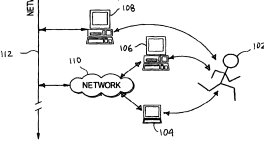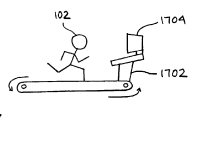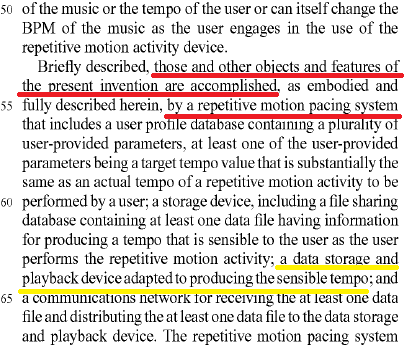

|
Pacing Technologies v. Garmin
International Inc. Fed.
Cir. Decision 2015/02/18
|
明細書の要約部(Summary of the Invention)の記載(詳細な特徴)によって 独立クレームが限定的に解釈された顕著な判決。
By
Tatsuo YABE 2015-04-20
|
|
まとめ(筆者コメント):
本事件は明細書の要約部(Summary
of the Invention)の記載(詳細な特徴)によって独立クレームが限定的に解釈された顕著な判決である。 本件特許明細書(Pacing社)の要約部には19項目の発明の目的が列記されている。それだけで独立クレームが減縮解釈されるというわけではないが、それら19項目の目的を達成するために・・と続く発明の構成要件に独立クレームの構成要件よりもかなり詳細な特徴を記載していた。両当事者間にとっての争点(侵害・非侵害の分岐点)はクレームの構成要件であるplayback
deviceが「ユーザーが感知できるテンポを生成する」ことを要件とするか(クレームには当該特徴は記載されておらず、Garmin社の形態は当該特徴を備えていない)であった。しかし発明の要約部に、当該playback
deviceに相当する詳細な特徴(ユーザーが感知できるテンポを生じる)が記載されており問題となった独立クレームを減縮解釈すると判断された(Garmin非侵害と判断された)。
|
昨今の(日本出願を基礎とする)米国出願の明細書の「発明の要約部(Summary
of the Invention)」には通常最も広範な独立クレームに対応する記載のみとするというプラクティスが多い。 そのような場合には本事件のような減縮解釈をされるという不利益を受けることはない。然し今日でもSummary
of the Inventionのセクションに従属クレームの特徴及び対応する作用効果を列記している場合もある。然るにそのような場合には本判決に鑑み、米国明細書作成の仕方を見直すことが重要と思料する。
|
さらに、本判決はどのような場合にクレームのプレアンブルが限定と解釈されるか、さらにクレームの用語がその一般的な意味合いを超えた(離反あるいは異なる)解釈となるかに関して過去のCAFC判決を集積して注意を喚起している。ベテランの実務者にとっては再確認、また、初心者にとっては学習材料となると考えます。
|
****************************************************
■
Lourie, Moore, Reyna判事:
Moore判事による意見(2015年02月18日)の概要:
|
特許権者: Pacing International社
問題となった特許:米国特許第8,101,843号
被疑侵害者: Garmin International
Inc.
|
■問題となった特許クレーム(発明)の概要:
陸上走行、自転車走行、水泳などの繰り返しを要する運動中のユーザーにペースを与える手法及びシステムに関する。好適実施例としては、音声リズム、或いは、光の点滅によってユーザーが所望する運動ペースに相当するテンポを与えユーザーがペースを掴みやすいようにす形態を開示。


|
■被疑侵害の形態:
Garminの装置はユーザーの特定する運動に応じた時間(残り時間)などを表示するが音楽或いはリズムを出力するものではない。
|
■事件の背景:
地裁判決(Garminのデバイスはクレーム25の再生装置”playback
device”の要件を満たさない。843特許の明細書を参酌すると”playback
device”は音声、ビデオ、又は、視覚可能な信号によって目標とするテンポ或いはペースを再生する。依って843特許のクレーム25を侵害していない)を不服としPacingによる控訴。
|
■
代表的なクレームは以下の通り:
Claim
25 of the ’843 patent,
(emphases added):
A repetitive motion pacing system
for pacing a user comprising:
a web site adapted to allowing the user to preselect from a set of
user-selectable activity types an activity they wish to perform and entering one
or more target tempo or target pace values corresponding to the activity;
a data storage and playback device;
and
a communications device adapted to transferring data related to the
pre-selected activity or the target tempo or the target pace values between the
web site and the data storage and playback device.
|
■争点:
クレーム25のみが争点となった。より詳細にはクレーム25はユーザーにペース情報(音声ビート或いは点滅等のテンポによる)を再生することを要件とするか、さらには、プレアンブルの”a
repetitive motion pacing system for pacing a user”というフレーズが、ユーザーが感知できるテンポを生じる(produce
a sensible tempo)という限定を含むか否かである。
|
■
CAFC判決概要
クレーム25のボディにはユーザーが感知できるテンポを生じるという特徴は記載されていない。依って、クレームを通常の意味合いで解釈するならばそのような特徴(感知できるテンポを生成する)はクレームの構成要件とはならない。本事件においてクレーム25のプレアンブルの”a
user”はクレームのボディ(”the user”)の先行詞となっている。依って、クレーム25のプレアンブルはクレームの構成要件と見做す。Summaryのセクション(Summary
and Objects of the invention)に発明の目的を複数列記することは一般的なことである。 本件特許明細書においてはコラム3〜コラム4の52行目まで19項目の発明の目的が列記されている。それらを列記することのみで発明を限定的解釈するというわけではない。 然しながら、本件特許明細書のコラム4の53行目以降にこれら目的(19項目)を達成するために・・・と続き、発明の構成要件が記載されている。
|

|
当該構成要件の中でa data
storage and playback device adapted to producing the sensible tempoと記載されている。 依って、クレーム25はユーザーが感知できるテンポを生じることを構成要件としていると判断される。 然るに、地裁の略式判決(Garmin非侵害)を支持する。
|
|
----------------------------------------------------------------------------
|
|
■本判決文の中で出願実務に重要な判示事項が列記されている。
|
(1)プレアンブルがクレームの限定となるか否かに関して:
“Preamble language that merely
states the purpose or intended use of an invention
is generally not treated as limiting the scope of the claim.” – Bicon,
Inc. v. Straumann Co. (Fed. Cir. 2006)
|
“when
limitations in the body of the claim rely upon and derive antecedent basis from
the preamble, then the preamble may act as a necessary component of the
claimed invention.” – Eaton Corp. v. Rockwell Int’l Corp (Fed. Cir.
2003)
|
(2)クレーム用語はどのような場合に一般的な意味合いの解釈(Phillips
v. AWH: Fed Cir. en
banc 2005)から離反するのか?
|
明細書或いは経過書類(審査経過書類)によって出願人が辞書の編集人(lexicography)となるか、或いは、否定(diavowal)がある場合のみである。-
Thorner v. Sony Computer Entm’t Am. LLC, (Fed. Cir. 2012)
|
これら(Lexicography –
Disavowal)の何れかに該当するか否かの判断は厳格な明白性が要求される。-
GE Lighting Solutions v. AgiLight Inc., (Fed. Cir. 2014)
|
To act as a lexicographer, a
patentee must “clearly set forth a definition of the discpited claim term”
and “clearly express an intent to define the term.” – Thorner,
|
Similarly, disavowal requires
“the specification [or prosecution history] make[] clear that the invention
does not include a particular feature.” – SciMed Life Sys. V.
Advanced Cardiovascular Sys. (Fed. Cir. 2001)
|
(3)以下のような場合にCAFCは
“disavowal (disclaimer)”と理解した:
We (Fed. Cir.) have found disavowal or disclaimer based on clear and
unmistakable statements by the patentee that limit the claims, such as “the
present invention includes . . .” or “the
present invention is . . . ” or “all
embodiments of the present invention are . . . .”- Regents
of Univ. of Minn. v. AGA Med.
Corp., (Fed. Cir. 2013); Honeywell
Int’l, Inc. v. ITT Indus., Inc., (Fed. Cir. 2006); SciMed Life Sys., Inc.
|
We (Fed. Cir.) have found disclaimer when the specification
indicated that, for “successful manufacture,”
a particular step was “require[d].” - Andersen
Corp. v. Fiber Composites, LLC,
(Fed. Cir. 2007).
|
We (Fed. Cir.) have found disclaimer when the specification
indicated that the invention operated by “pushing (as opposed to pulling)
forces,” and then characterized the “pushing forces”
as “an important feature of the present
invention.”
|
We (Fed. Cir.) also have found disclaimer when the patent repeatedly
disparaged an embodiment as “antiquated,” having “inherent
inadequacies,” and then detailed the “deficiencies [that] make it
difficult” to use. - Chi. Bd.
Options Exch., Inc. v. Int’l Sec.
Exch., LLC,
(Fed. Cir. 2012).
|
Likewise, we (Fed. Cir.) have used disclaimer to limit a claim element to a
feature of the preferred embodiment when the specification described that
feature as a “very important feature. . . in an
aspect of the present invention,” and disparaged
alternatives to that feature. - Inpro
II Licensing, S.A.R.L. v.
T-Mobile USA Inc., (Fed. Cir. 2008).
|
When a patentee “describes the features of the ‘present invention’ as
a whole,” he alerts the reader that “this description limits the scope of
the invention.” AGA Med. Corp.,
717 F.3d at 936.|
|
|
----------------------------------------------------------------------------
|